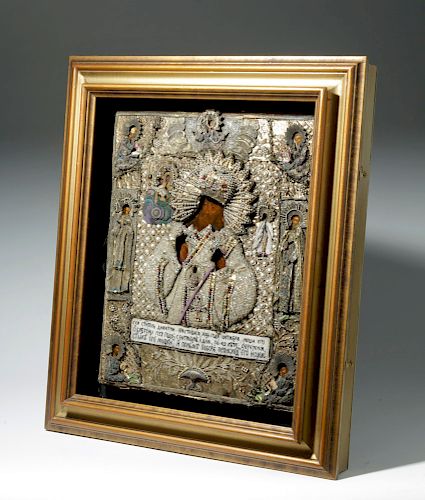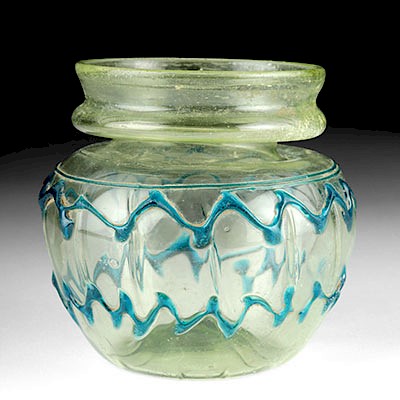19th C. Russian Icon w/ Oklad - Metropolitan Alexei
Lot 297
About Seller
Artemis Fine Arts
686 S Taylor Ave, Ste 106
Louisville, CO 80027
United States
Selling antiquities, ancient and ethnographic art online since 1993, Artemis Gallery specializes in Classical Antiquities (Egyptian, Greek, Roman, Near Eastern), Asian, Pre-Columbian, African / Tribal / Oceanographic art. Our extensive inventory includes pottery, stone, metal, wood, glass and textil...Read more
Estimate:
$4,500 - $6,750
Absentee vs Live bid
Two ways to bid:
- Leave a max absentee bid and the platform will bid on your behalf up to your maximum bid during the live auction.
- Bid live during the auction and your bids will be submitted real-time to the auctioneer.
Bid Increments
| Price | Bid Increment |
|---|---|
| $0 | $25 |
| $300 | $50 |
| $1,000 | $100 |
| $2,000 | $250 |
| $5,000 | $500 |
| $10,000 | $1,000 |
| $20,000 | $2,500 |
| $50,000 | $5,000 |
| $100,000 | $10,000 |
| $200,000 | $20,000 |
About Auction
By Artemis Fine Arts
Aug 16, 2018
Set Reminder
2018-08-16 10:00:00
2018-08-16 10:00:00
America/New_York
Bidsquare
Bidsquare : Clearance Sale - Ancient / Ethnographic Art
https://www.bidsquare.com/auctions/artemis-gallery/clearance-sale---ancient-ethnographic-art-3368
These lots are going, going, gone... plus a nice selection of lots brand-new to auction! Artemis Fine Arts info@artemisfinearts.com
These lots are going, going, gone... plus a nice selection of lots brand-new to auction! Artemis Fine Arts info@artemisfinearts.com
- Lot Description
**Originally Listed At $2500**
Eastern Europe, Russia, ca. 19th century CE. Finely painted in egg tempera and gold leaf on wood depicting Metropolitan Alexei surrounded by holy personages - luxuriously embellished with an elaborate pearl and glass bead embroidered oklad with sheets of gold leaf applied to the ground and countless gilded threads, mounted in a gold-toned wooden shadow box frame. Beneath Alexei is a painstakingly beaded black-on-white calligraphic text panel presumably providing extensive narrative and identification. A very refined example, replete with meaningful religious symbolism, remarkable technique, and the utmost artistry. Size: 23.5" W x 27.75" H (59.7 cm x 70.5 cm)
The metropolitan was originally the highest office in the Russian Orthodox Church. Although Byzantine emperors were esteemed for their theocratic ideals, Russian princes derived their holiness from their military prowess. Alexander Nevskii (1220-1263) was among the first princes to fight for the freedoms of Holy Russia; he battled the Tatars, the Swedes, as well as the Teutonic knights. Saints Peter (metropolitan from 1308 to 1326), Alexis (1354-78), Jonah (1449-61), and Philip (1566-69) were the four great Russian hierarchs and metropolitans from Moscow. Alexis excommunicated rebel princes and fostered Russian victory against the Tatars at Kulikovo.
Icons (icon means "image" in Greek) are sacred objects within the Eastern Orthodox Christian tradition. Found in homes as well as churches, these painted images depict holy persons and saints as well as illustrate scenes from the Scriptures. Some icons are encased in glass-fronted wooden cases (kiots) or precious metal or embroidered covers (oklads) adorned with pearls and semi-precious or glass stones like this example. Icons are not worshiped, but are instead venerated for their ability to focus the power of an individual's prayer to God. As such they are truly "windows into heaven." The oklad or riza, sometimes referred to as a revetment in English, is a metal or in this case a richly embroidered beaded cover that not only protects the icon, but also serves to honor or venerate the figure(s) depicted on the icon.
Exhibited in "Windows Into Heaven: Russian Icons from the Lilly and Francis Robicsek Collection of Religious Art" at the Mint Museum of Art, Charlotte, North Carolina (December 20, 2003 through February 22, 2004) which presented highlights of one of the world's great artistic traditions through an extraordinary group of sixty-five 18th and 19th century Russian icons on loan from the private collection of Lilly and Francis Robicsek.
ThePainting of upper left figure shows areas of loss. The oklad shows some loose threads, fraying and missing trim, and missing beads; however, is in overall good condition. Minor wear to the frame, though still functional. A label on the verso from the Mint Museum exhibition in Charlotte, North Carolina (December 20, 2003 through February 22, 2004).Condition
- Shipping Info
-
All shipping is handled in-house for your convenience. Your invoice from Artemis Gallery will include shipping calculation instructions. If in doubt, please inquire BEFORE bidding for estimated shipping costs for individual items.
-
- Buyer's Premium



 EUR
EUR CAD
CAD AUD
AUD GBP
GBP MXN
MXN HKD
HKD CNY
CNY MYR
MYR SEK
SEK SGD
SGD CHF
CHF THB
THB




















